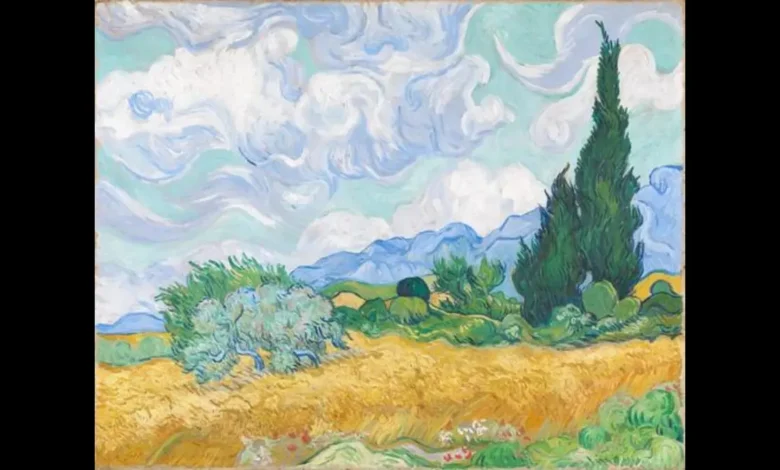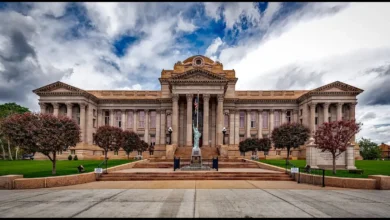Exploring the Roots of Art: The Artist Tree Unveiled


Introduction to the Concept of the Artist Tree
Welcome, art enthusiasts and nature lovers, to a world where creativity intertwines with the beauty of Mother Nature. Today, we embark on a journey that unravels the mesmerizing concept of the Artist Tree – a symbol deeply rooted in artistic expression throughout history.
Picture yourself standing beneath a majestic tree, its branches reaching toward the sky like outstretched fingers of inspiration. Feel the gentle rustle of leaves whispering secrets only artists can comprehend. This is where imagination takes flight, and artistry finds its roots.
In this blog post, we will delve into the historical significance behind trees as symbols in art and explore various interpretations of artist trees across cultures. From famous examples throughout art history to modern applications, let us discover how these symbolic representations bring forth our inner artists and connect us with nature’s grandeur and creative potential.
So grab your metaphorical paintbrushes and join me as we unveil the captivating world of the Artist Tree!
Historical Background on the Symbolism of Trees in Art
The use of trees as a symbol in art dates back centuries, with roots deep in various cultures and artistic traditions. Across different civilizations, trees have held significant meanings and have been depicted in countless artworks.
In ancient times, the tree was seen as a powerful representation of life, growth, and connection to the divine. For example, in Egyptian art, the sycamore tree was often associated with rejuvenation and rebirth. In Norse mythology, Yggdrasil represented an enormous ash tree that connected different realms of existence.
During the Renaissance, artists incorporated trees into their landscapes to convey specific messages or moods. The oak tree symbolized strength and endurance, while cypress trees were often associated with death and mourning. Artists like Albrecht Dürer used these symbolic elements to enhance their compositions.
Trees convey harmony between humans and nature in Eastern art forms such as Chinese paintings or Japanese woodblock prints (ukiyo-e). The cherry blossom tree became synonymous with transience and beauty, while pine trees symbolized longevity and resilience.
In more recent history, modernist painters like Gustav Klimt embraced symbolism through decorative patterns depicting stylized branches or foliage. Trees added visual interest and conveyed emotions such as mystery or serenity.
Today, contemporary artists continue to explore the symbolism of trees within their works using various mediums, including sculpture, photography, installations, etc… They tap into this rich historical background while infusing it with personal narratives or cultural references.
The symbolism of trees in art is multifaceted – representing growth, wisdom, and interconnectedness but also change or renewal. It serves as a reminder for us to reconnect with nature’s beauty around us while reflecting on our journey through life.
The Different Types of Artist Trees and Their Meanings
When it comes to artist trees, there is a wide variety of options with different meanings and symbolism. One popular type is the oak tree, which represents strength, endurance, and wisdom. Its sturdy branches and deep roots symbolize resilience and grounding, making it a perfect choice for artists seeking stability in their creative journey.
Another common artist tree is the willow tree. With its graceful drooping branches that sway in the breeze, the willow embodies flexibility and adaptability. Artists who connect with this tree often embrace change and are open to exploring new artistic styles or mediums.
For those seeking inspiration and creativity, the birch tree may be their muse. Known for its beautiful white bark and delicate leaves, the birch symbolizes purity and freshness. Artists drawn to this tree often find themselves inspired by nature’s beauty.
The maple tree is another favorite among artists due to its vibrant colors during autumn months – reds, oranges, yellows – representing transformation. Maple trees also evoke warmth and comfort; they can bring a sense of coziness into an artwork.
Last but not least (if I may say so), we have the pine tree – synonymous with resilience throughout harsh winter seasons! For artists looking for strength through challenging times or wanting to evoke a sense of tranquility within their work – look no further than these evergreen beauties!
In conclusion (I know you said not to conclude, but bear with me on this one), each type of artist tree carries its unique meaning that resonates differently with individuals’ artistic journeys. Whether you seek strength from an oak or flexibility from a willow, embracing these symbols can help you deeply tap into your inner creativity! So explore these artist trees and let them guide your brushstrokes or inspire your words!
Famous Examples of Artist Trees in Art History
Throughout history, artists have found inspiration in the beauty and symbolism of trees. These majestic beings have often been a muse for painters, sculptors, and other creative minds. Let’s look at some famous examples of artist trees in art history.
One notable example is Vincent van Gogh’s iconic painting “The Olive Trees.” In this masterpiece, van Gogh captured the essence of nature through his bold brushstrokes and vibrant colors. The twisting branches and textured leaves convey a sense of movement while symbolizing growth and vitality.
Another renowned artist who explored the theme of trees was Gustav Klimt. His painting “The Tree Of Life” is an intricate depiction of a tree with intertwining branches adorned with colorful flowers and fruits. Klimt believed that the tree represented the connection between heaven and earth, symbolizing life’s interconnectedness.
In Japanese art history, Hokusai’s woodblock print series, “Thirty-Six Views Of Mount Fuji,” features numerous depictions of trees alongside the iconic mountain landscape. These prints showcase Hokusai’s mastery of capturing natural elements like waves, clouds, and man-made structures such as bridges or pagodas amidst lush forests.
Moving on to more contemporary works, we can’t forget about Andy Goldsworthy’s incredible installations made entirely from natural materials found in forests or fields. His sculptures often involve arranging leaves or twigs into intricate patterns harmonizing with their surroundings. Goldsworthy aims to emphasize our connection to nature by creating temporary artworks that eventually return to their organic state.
These are just a few examples showcasing how artists throughout history have celebrated the beauty and symbolism of trees within their artwork. Whether through paintings, sculptures, or installations, these artists remind us to appreciate our natural surroundings while sparking our creativity.
Modern Interpretations and Applications of the Artist Tree
In the modern world, the concept of the Artist Tree has taken on new and exciting interpretations. Artists today are not limited to traditional mediums or styles; they are breaking boundaries and exploring new ways to express themselves. The Artist Tree is no longer confined to canvas or sculpture but can be found in digital, performance, street, and interactive installations.
One modern interpretation of the Artist Tree is through technology. Digital artists use software and coding to create stunning visual experiences that challenge our perceptions of what art can be. With virtual reality and augmented reality becoming more accessible, artists can immerse their audiences in a whole new world where trees come alive with vibrant colors and unexpected shapes.
Another application of the Artist Tree in modern times is its role as a symbol of environmental activism. As we face increasing climate change challenges, many artists use their creativity to raise awareness about deforestation, pollution, and biodiversity loss. Through powerful installations made from recycled materials or thought-provoking photographs capturing nature’s beauty at risk, these artists urge us to take action before it’s too late.
Social media has also transformed how artists share their work with the world. Platforms like Instagram allow them to reach a global audience instantly while connecting with other like-minded creatives for collaboration opportunities. The hashtag #ArtistTree has become a virtual gallery where diverse artistic expressions converge – painting, photography, mixed media – all celebrating nature’s beauty and inspiring others.
Additionally, community engagement projects have become popular among contemporary artists who seek to unite people through shared creative experiences centered around trees as symbols of growth and connection. From mural painting events inviting locals to participate in beautifying public spaces with tree-themed artwork to outdoor workshops teaching sustainable practices through eco-art techniques – these initiatives foster unity while promoting environmental stewardship.
As we delve into ever-evolving interpretations of the Artist Tree phenomenon in our present-day society, it becomes evident that this timeless symbol continues to capture the imagination of artists and audiences alike. By embracing the power
The Connection between Nature, Creativity, and the Human Mind
The beauty of nature has always captivated the human mind, inspiring creativity in countless ways. From the vibrant colors of a sunrise to the intricate patterns found in a single leaf, nature’s wonders ignite our imaginations and fuel our artistic endeavors.
When we immerse ourselves in the great outdoors, something magical happens. Our senses awaken as we breathe in fresh air, listen to birdsong, and feel the gentle touch of a breeze on our skin. Our minds become open and receptive to new ideas in this connection with nature. We begin to see things differently – shapes take on new meanings, colors evoke emotions, and textures inspire tactile creations.
Nature acts as both a muse and teacher for artists across various mediums. Painters draw inspiration from landscapes that speak volumes about light and shadow; writers find solace beneath the sheltering canopy of towering trees; sculptors mold clay into organic forms reminiscent of natural structures.
Creativity often flourishes when stepping outside conventional boundaries and entering untamed wildernesses or urban green spaces. The symphony of sounds, sights, smells – all merge within us like an orchestra playing its most harmonious composition.
Moreover, studies have shown that spending time in nature can improve cognitive function by reducing stress levels and enhancing mental clarity. It allows us to escape daily pressures while reconnecting with our inner selves.
Indeed, there is an undeniable connection between nature’s abundance and boundless creativity within each individual’s unique mind- it is up to us to explore these connections further! By embracing nature as a wellspring for creative inspiration, genuinely understanding how deeply rooted artistry lies within ourselves will unleash unlimited potential for innovation!
Conclusion: Embracing the Inner Artist within us through the Symbolism of Trees
Embracing the Inner Artist within us through the Symbolism of Trees
As we conclude our exploration of the roots of art and delve into the fascinating world of artist trees, one thing becomes abundantly clear. A profound connection exists between nature, creativity, and the human mind. Artists have found solace, inspiration, and reflection in trees throughout history. From ancient religious symbolism to modern interpretations in various art forms, the artist tree remains a powerful symbol that resonates with both creators and admirers alike.
By understanding the historical background of the symbolism of trees in art, we gain insight into how these majestic beings have been revered as representations of life’s cycles and spiritual growth. Whether it be through their strong trunks or far-reaching branches reaching towards unlimited possibilities, trees embody resilience and strength—qualities that artists often seek to capture in their works.
The different artist tree types hold unique meanings that further enrich our understanding. The towering oak might speak to stability and endurance, while delicate cherry blossoms can evoke beauty and fleeting moments. Each type invites contemplation on concepts such as unity with nature or personal transformation—a reminder for artists to find inspiration from external sources and within themselves.
Throughout art history, countless famous examples showcase how artists have incorporated trees into their works to convey more profound messages or emotions. Think back to Van Gogh’s mesmerizing “Starry Night,” where swirling cypress trees depict movement alongside celestial bodies—an expression of his turbulent inner thoughts. Or consider Monet’s enchanting series depicting water lilies surrounding a pond framed by willow trees—an invitation for viewers to immerse themselves in tranquility.
In contemporary times, modern interpretations continue pushing boundaries when incorporating artist tree symbolism across various mediums. From intricate sculptures crafted from recycled materials mimicking organic forms found in forests to digital artwork portraying virtual worlds where nature merges seamlessly with technology—the artistic possibilities are infinite! These innovative approaches remind us that the artist tree remains a versatile symbol, open for reinterpretation.
you may also read digitalfastnews.





